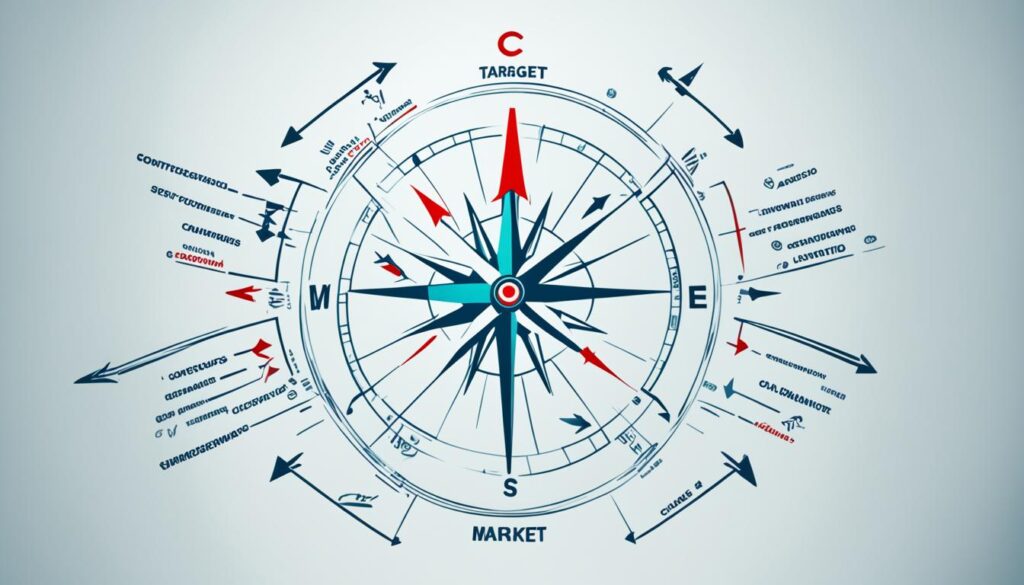A go-to-market (GTM) strategy is essential for businesses seeking to expand their customer base and achieve sustainable growth. By effectively implementing go-to-market strategies, companies can launch new products or services, enter new markets, and establish a competitive edge in their industry.
Developing an effective GTM strategy involves careful planning and consideration of various factors such as target audience, market positioning, messaging, and distribution channels. By following key steps in crafting a successful GTM strategy, businesses can maximize their chances of achieving their marketing goals and driving business growth.
Key Takeaways:
- A go-to-market (GTM) strategy is a roadmap for launching a new product or expanding into a new market.
- An effective GTM strategy involves understanding your target audience, identifying market opportunities, and creating a compelling value proposition.
- Successful GTM strategies require meticulous planning, collaboration, and continuous evaluation to adapt to changing market conditions.
- Implementing a GTM strategy can lead to increased customer acquisition, revenue growth, and a sustainable competitive advantage.
- Businesses should continuously refine their GTM strategies based on market feedback and performance metrics to optimize results and ensure long-term success.
What is a Go-to-Market Strategy?
A go-to-market (GTM) strategy is a vital plan that outlines the step-by-step process for successfully launching a new product or expanding an existing product into a new market. Implementing a well-crafted GTM strategy ensures that your product is introduced to the right audience at the right time, maximizing your chances for a successful new product launch and customer acquisition.
At its core, a go-to-market strategy is designed to answer fundamental questions that shape your product’s journey in the market. It encompasses crucial aspects such as:
- Defining the unique problem your product solves
- Identifying your target audience
- Understanding their pain points
- Selecting the appropriate channels to sell your product
- Creating effective strategies to reach and engage your target customers
A well-crafted go-to-market strategy ensures that your product launch is focused, targeted, and aimed at a market that isn’t already saturated with similar offerings. By conducting thorough market research, understanding your target audience’s needs, and leveraging effective marketing and sales strategies, you can position your product as the ideal solution, leading to successful customer acquisition and business growth.
To illustrate the importance of a GTM strategy, let’s look at an example:
Oatly, a Swedish company known for its dairy alternatives, successfully expanded into the US market through a well-executed go-to-market strategy. They identified their target audience as consumers seeking dairy-free options and launched their product directly in coffee shops, where this specific audience gathered. By precisely targeting the right audience and addressing their needs, Oatly experienced a remarkable ten-fold revenue increase between 2017 and 2018.
Implementing a go-to-market strategy not only helps you avoid costly mistakes but also maximizes your customer acquisition efforts, ensuring that your product resonates with the right audience in a competitive market landscape.
Go-to-Market Strategy vs. Marketing Plan
A go-to-market strategy (GTM) and a marketing plan may sound similar, but they serve different purposes in your business growth journey. Let’s clarify the distinction between the two.
A go-to-market strategy is specifically designed for launching a product or expanding into a new market. It addresses the unique challenges and opportunities of that specific product or market. In contrast, a marketing plan is a long-term approach that outlines how you will execute your overall marketing strategy to achieve your marketing objectives over time.
When developing a GTM strategy, you focus on the intricate details of the product launch or market expansion, taking into account factors like target audience, positioning, messaging, and distribution channels. The GTM strategy ensures that your product reaches the right audience at the right time, maximizing its chances of success.
A GTM strategy is like a blueprint for your product launch, guiding you through the critical steps and actions necessary to achieve your desired outcomes.
On the other hand, a marketing plan takes a broader perspective, considering the long-term goals of your business. It outlines the overall marketing strategy and the tactics you will use to achieve those goals, encompassing various elements like branding, advertising, public relations, and customer engagement.
A marketing plan provides a roadmap for your business’s sustained growth by outlining the strategies and initiatives you will undertake to consistently reach and engage with your target audience.
Let’s explore a couple of real-life examples to see the distinction more clearly. Sephora, a renowned cosmetics retailer, has a marketing plan that focuses on building customer loyalty through its loyalty program. They use various tactics like personalized recommendations, exclusive offers, and rewards to create a strong bond with their customers over the long term.
Contrastingly, when Microsoft launched its Surface tablet, they executed a go-to-market strategy to tackle a specific market problem. Their GTM strategy involved targeting creative professionals who needed a powerful and portable device for their work, positioning the Surface as the ideal solution.
By understanding the difference between a go-to-market strategy and a marketing plan, you can ensure that you have a well-defined approach for both your product launches and your long-term marketing efforts, setting yourself up for sustainable growth.

Key Takeaways:
- A go-to-market strategy is tailored for launching a product or entering a new market, addressing specific challenges and opportunities.
- A marketing plan focuses on executing the overall marketing strategy to achieve long-term objectives.
- GTM strategies are like blueprints for successful product launches, while marketing plans provide a roadmap for sustained business growth.
- Having a clear understanding of both GTM strategies and marketing plans is essential for effectively reaching your target audience and maximizing your business’s potential.
Organizing Your Go-to-Market Strategy
A go-to-market strategy involves multiple moving pieces, making it important to have a system to organize and manage the plan. A project management platform can help you visualize your entire GTM strategy in one place, including the status, owners, and dependencies of each task. It allows for real-time collaboration and updates as team members execute the strategy. This ensures that everyone is on the same page and can track progress, making it easier to stay organized and meet deadlines.
When it comes to managing your go-to-market strategy, project management tools are invaluable. They provide a centralized hub where you can break down your strategy into actionable tasks, assign responsibilities to team members, and set deadlines. With features like Gantt charts and task dependencies, you can easily visualize your plan and identify any potential bottlenecks or delays.
Real-time collaboration is another significant advantage of using project management software for your GTM strategy. Team members can collaborate on tasks, share updates, and communicate in real-time, regardless of their geographical location. This fosters seamless collaboration, ensures everyone is aligned and accountable, and allows for quick decision-making when faced with unexpected challenges.
Furthermore, project management platforms offer advanced reporting and analytics capabilities, allowing you to track the progress and performance of your go-to-market strategy. You can generate insightful reports and metrics that provide valuable insights into the effectiveness of your strategy, helping you identify areas of improvement and make data-driven decisions.
Benefits of Organizing Your Go-to-Market Strategy with Project Management:
- Centralized hub for organizing and managing your entire GTM strategy.
- Visualize your plan with ease using features like Gantt charts and task dependencies.
- Enable real-time collaboration and communication among team members, regardless of location.
- Enhance accountability and ensure everyone is on the same page.
- Track progress and performance with advanced reporting and analytics.

By utilizing a project management platform for your go-to-market strategy, you can streamline your processes, foster collaboration, and increase the chances of a successful product launch. Remember, effective organization and real-time collaboration are crucial elements for executing a well-planned and impactful GTM strategy.
Conclusion
A well-crafted go-to-market strategy is essential for a successful product launch and driving business growth. By implementing a comprehensive GTM strategy, you can effectively identify your target audience, position your product as a solution to their pain points, and execute your marketing and sales strategies with precision.
Following the nine steps outlined in this article will guide you in creating a solid go-to-market strategy, increasing your chances of a successful product launch. However, it’s crucial to remember that success does not stop at the launch. Continuously evaluating and adjusting your strategy based on market conditions and customer feedback is vital to maximizing your growth potential.
Furthermore, staying flexible and agile in your approach is key. The business landscape is constantly evolving, and adapting to changing market dynamics and consumer demands is crucial to sustaining momentum and achieving long-term success. By incorporating customer insights and market intelligence into your go-to-market strategy, you can stay ahead of the competition and drive remarkable business growth.
FAQ
What is a go-to-market (GTM) strategy?
A go-to-market (GTM) strategy is a step-by-step plan for launching a new product or expanding into a new market. It helps you launch your product to the right audience, with the right messaging, at the right time.
Why is a go-to-market strategy important?
A well-crafted GTM strategy ensures that you are launching your product to the right audience and in a market that is not already saturated with similar offerings. It helps you avoid costly mistakes and maximize customer acquisition.
How is a go-to-market strategy different from a marketing plan?
A go-to-market strategy is specifically for launching a product or expanding into a new market, while a marketing plan details how you will execute your overall marketing strategy. The GTM strategy is tailored to a specific launch, addressing the unique challenges and opportunities of that product or market.
How can I organize and manage my go-to-market strategy?
A project management platform can help you visualize your entire GTM strategy in one place, including the status, owners, and dependencies of each task. It allows for real-time collaboration and updates as team members execute the strategy, making it easier to stay organized and meet deadlines.
How can a well-crafted go-to-market strategy contribute to business growth?
A well-crafted go-to-market strategy helps you identify the right audience, position your product as a solution to their pain points, and execute your marketing and sales strategies effectively. By following the right steps, you can create a comprehensive GTM strategy and increase your chances of a successful product launch.








